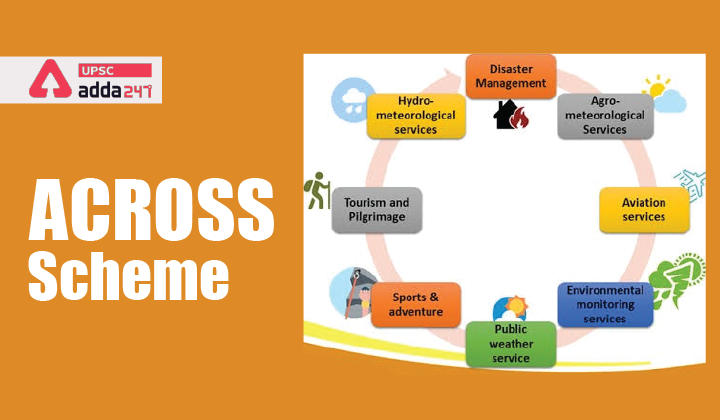Table of Contents
ACROSS scheme: Relevance
- GS 3: Achievements of Indians in science & technology; indigenization of technology and developing new technology.
ACROSS scheme: Context
- The Cabinet Committee on Economic Affairs has recently approved the continuation of ACROSS scheme along with its eight sub-schemes to the next finance cycle of five years i.e., 2021-2026.
ACROSS scheme: Key points
- ACROSS (Atmosphere & Climate Research-Modelling Observing Systems & Services) scheme is an atmospheric science program of Ministry of Earth Sciences (MoES) and addresses different aspects of weather and climate services.
- Each of these aspects is incorporated as eight sub-schemes under the umbrella scheme “ACROSS” and is implemented in an integrated manner through the aforesaid four institutes.
- The scheme is being implemented by the Ministry of Earth Sciences (MoES) through its units namely
- India Meteorological Department (IMD);
- National Centre for Medium Range Weather Forecasting (NCMRWF);
- Indian Institute of Tropical Meteorology (IITM) and
- Indian National Centre for Ocean Information Services (INCOIS).
ACROSS scheme: Sub-missions
Monsoon Convection, Clouds, and Climate Change (MC4)
- The MC4 scheme was envisioned to improve the observational database and climate models for enhanced predictive understanding of monsoonal precipitation changes and their impacts in a warming environment.
- The overarching goal of MC4 is to describe better and quantify interactions among monsoon dynamics, clouds, aerosols, precipitation and water cycle in a changing climate.
- It will be accomplished by climate modelling and observational studies and would enable improved prediction of climatic variations and regional impacts over south Asia.
Sub programs of MC4
- Centre For Climate Change Research (CCCR) including virtual water centre
- Physics and Dynamics of Tropical Clouds (PDTC)
- Atmospheric Research Testbeds (ART) for process studies and National Climate Reference Network (NCRN)
- Metro Air Quality and Weather Service (MAQWS)
High Performance Computing System (HPCS)
- The existing HPCS resources of 6.8 petaflops (PF) commissioned in 2018 has resulted in improved short-medium scale forecasts with the usage of high-resolution models.
- For further enhancing weather and climate prediction, high-resolution dynamical models are required, which are highly computationally intensive.
Monsoon Mission (MM-II)
- The second phase of monsoon mission (MM-II), which began in September 2017, focuses on predicting weather/climate extremes and development of climatic applications based on monsoon forecasts, especially in the field of agriculture, hydrology and energy sector.
- In MM-II, focus has been given to high-resolution short-range predictions, predicting extremes, and using forecasts to develop applications for agriculture, hydrology, disaster management, energy sector, etc.
- Ministry of Earth Sciences (MoES), Government of India, launched the National Monsoon Mission (NMM) in 2012 (now referred as Monsoon Mission, MM).
Atmospheric Observations Network
- The scheme Atmospheric Observations Network of IMD is a continuing scheme primarily encompassing ongoing programs in an integrated manner aimed at sustenance of observational network.
Weather & Climate Services
- The scheme Weather & Climate Services of IMD is a continuing Scheme primarily encompassing ongoing programs in an integrated manner aimed at providing efficient weather and climate services.
- IMD provides services to weather-sensitive sectors viz. agriculture, irrigation, shipping, aviation, offshore oil explorations, etc.
Upgradation of Forecast System
- Upgradation of Forecast System is aimed at improving the accuracy of weather forecasts to bring it at par with the international standards which will help many sectors like army operations, air operation, agriculture, tourism, etc.
Commissioning of Polarimetric Doppler Weather Radars (DWRs)
- Induction of an adequate number of DWRs in the network would facilitate plugging the existing gaps in the meteorological observational network of radars, desirable for effective and efficient analysis and consequent forecasting.
- The availability of countrywide weather radar coverage and its integration, including overlapping regions of the proposed network would provide adequate warning in the event of approach of Cyclonic Storms, Monsoon Depressions, etc.



 TSPSC Group 1 Question Paper 2024, Downl...
TSPSC Group 1 Question Paper 2024, Downl...
 TSPSC Group 1 Answer key 2024 Out, Downl...
TSPSC Group 1 Answer key 2024 Out, Downl...
 UPSC Prelims 2024 Question Paper, Downlo...
UPSC Prelims 2024 Question Paper, Downlo...




